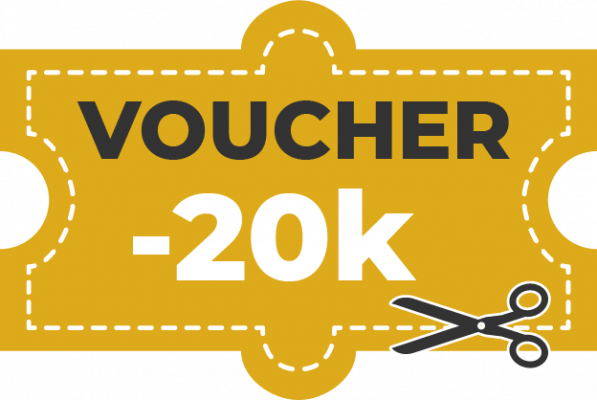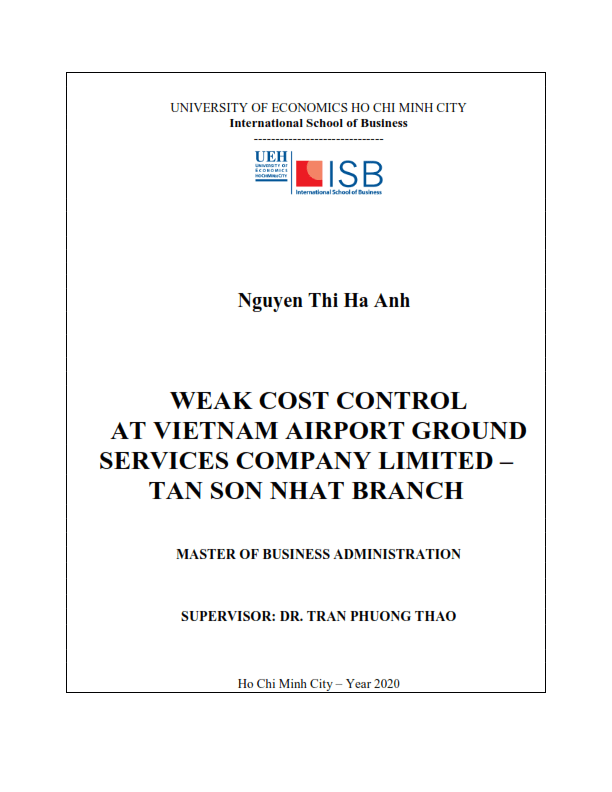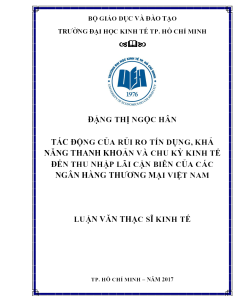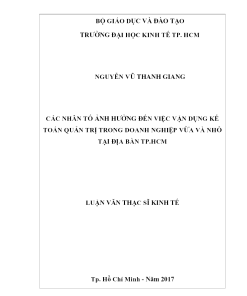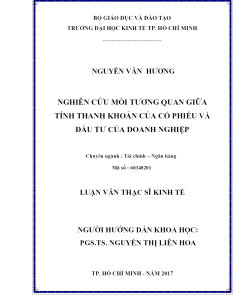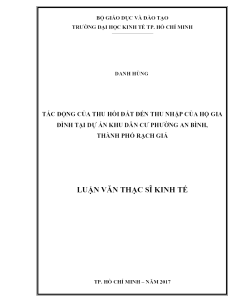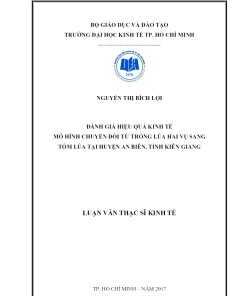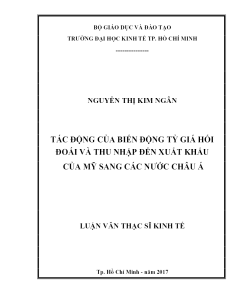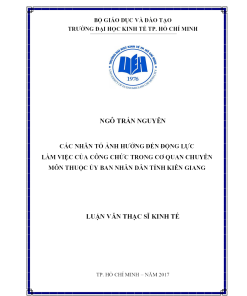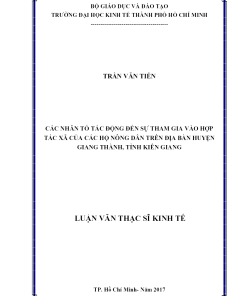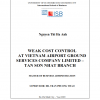Download Master Thesis: Weak cost control at Vietnam Airport Ground Services Company Limited – Tan Son Nhat branch (ThS08.089)
In the context of the current developed and competitive economy, all businesses set goals for production, business and sustainable development. Finding the optimal financial solution for the sustainable development strategy in this period is always the most difficult problem for small and medium enterprises today. Therefore, according to experts, one of the measures that every business must take into account is managing and saving costs more and more effectively called cost control so that its products and services quality and price are more suitable for customers. Cost controll and cost savings are the most effective way to control your business’s operations. The purpose of the thesis is to find out the main problem that VIAGS TSN is facing – the problem of cost control and the main cause of cost control in the company. In-depth interview with two managers of two main departments of the company – the accounting department and the sale and planning department are conducted to understand and identify the main reasons of poor cost control at VIAGS TSN. From there the author will propose the solution to solve the problem most effectively.
ThS08.089_Weak cost control at Vietnam Airport Ground Services Company Limited – Tan Son Nhat branch
Table of Contents
EXECUTIVE SUMMARY .....................................................................................................1
1 PROBLEM CONTEXT ....................................................................................................2
1.1 Background of Vietnam Airport Ground Services Company Limited – Tan Son Nhat
Branch (VIAGS TSN)................................................................................................................. 2
1.2 Symptoms: ................................................................................................................ 3
1.2.1 A decline of Gross profit ................................................................................... 3
1.2.2 Increase of Operating Cost ................................................................................ 4
2. PROBLEM IDENTIFICATION: ......................................................................................5
2.1 Possible problems:.............................................................................................................5
2.1.1 Poor outside purchasing services cost negotiation ............................................ 6
2.1.2 Ineffective fixed asset investment: .................................................................... 7
2.1.3 Weak cost control .............................................................................................. 9
2.2 Main problem validation .................................................................................................13
2.3 Problem definition and consequences: ............................................................................16
2.3.1 Problem definition: .......................................................................................... 16
2.3.2 Consequences ................................................................................................. 17
3. CAUSE VALIDATION:.................................................................................................18
3.1 Potential causes: ..............................................................................................................18
3.1.1 Ineffective cost budgeting: .................................................................................. 19
3.1.2 Incomplete standard cost system:........................................................................ 19
3.1.3 Weak cost variance analysis:............................................................................... 19
3.2 Cause validation:..................................................................................................... 20
3.2.1 Real causes:.............................................................................................................. 20
3.2.2 Main causes: ............................................................................................................ 24
4. SUGGESTED SOLUTIONS ..........................................................................................25
4.1 Alternative solutions: .............................................................................................. 25
4.1.1 The first solution: Cost classification.................................................................. 25
4.1.2 The second solution: Cost control throughout cost centers: ............................. 29
4.2 Solution selection:.................................................................................................. 30
4.3 Action plan in the organization.............................................................................. 31
5. SUPPORTING INFORMATION: ..................................................................................32
5.1 Summary of research methods in the study: ........................................................... 32
5.2 Interview guide: ...................................................................................................... 33
5.3 Interview transcripts: .............................................................................................. 34
6. REFERENCES:...............................................................................................................43
ACKNOWLEDGEMENTS
Firstly, I would like to acknowledge all who supported me during the time of thesis. Secondly, I would like to express my gratitude to my Supervisor – Dr Tran Phuong Thao
who has supported me during the time doing this thesis. Without the guidance and support from
Supervisor, my thesis can not be completed promptly.
Thirdly, I would like to thank to my colleagues at work for their support.
And finally, I would like to express my deep sense of gratitude to my family members for sympathizing and encouraging me to complete my Master program
LIST OF FIGURES
Figure 1: VIAGS TSN structure
Figure 2: Business performance from 2017 to 2019
Figure 3: Production and business performance evaluation report
Figure 4: Initial Cause – effect Map
Figure 5: Fish bone diagram of main problem at VIAGS TSN Figure 6: Final Cause – effect Map
LIST OF TABLES
Table 1: VIAGS TSN business performance from 2017 to 2019
Table 2: VIAGS TSN business performance ratio (ROS) from 2017 to 2019
Table 3: VIAGS TSN business performance ratio from 2017 to 2019
Table 4: VIAGS TSN cost for production & business detail from 2017 to 2019
Table 5: New fixed assets investment in 2019
Table 6: Fuel consumption standard according to operating hours
Table 7: VIAGS TSN fuel cost from 2017 to 2019
EXECUTIVE SUMMARY
In the context of the current developed and competitive economy, all businesses set goals for production, business and sustainable development. Finding the optimal financial solution for the sustainable development strategy in this period is always the most difficult problem for small and medium enterprises today. Therefore, according to experts, one of the measures that every business must take into account is managing and saving costs more and more effectively called cost control so that its products and services quality and price are more suitable for customers. Cost controll and cost savings are the most effective way to control your business's operations.
The purpose of the thesis is to find out the main problem that VIAGS TSN is facing - the problem of cost control and the main cause of cost control in the company. In-depth interview with two managers of two main departments of the company - the accounting department and the sale and planning department are conducted to understand and identify the main reasons of poor cost control at VIAGS TSN. From there the author will propose the solution to solve the problem most effectively.
.
1
1 PROBLEM CONTEXT
1.1 Background of Vietnam Airport Ground Services Company Limited – Tan Son Nhat
Branch (VIAGS TSN)
Vietnam Airport Ground Services Company Limited (VIAGS) is established on Jan 01st 2016 on the basis of merging three ground service providers NIAGS, DIAGS and TIAGS.
- 1993: Noi Bai, Da Nang and Tan Son Nhat Airport Ground Services Founded.
- 2016: Launching VIAGS brand on the basis of merging 3 ground services companies.
The charter capital of the Company is VND 250 billion and the sole owner is Vietnam Airlines Corporation - JSC. VIAGS TSN is a branch of VIAGS at Tan Son Nhat Airport operating in carrier industry, major in ground handling services. Due to the unique nature of the ground handling services, Vietnam just have 3 companies operates in this industry: VIAGS, SAGS, HGS. VIAGS is considered the biggest and successful ground handling company with revenue more than 2.000 billion dong per year. Main customers of the company are international and domestic airlines like Vietnam airline, Air France airline, China airline, etc,…Main revenue of company comes from ground handling services includes: station management services, passenger and baggage handling services, ramp services, load control services, support services that serve arrival and departure flight of customer airlines. Beside that, VIAGS also provides other services like baggage delivery, training services, welcome services at Tan Son Nhat airport.
VIAGS TSN is the branch has the biggest size about revenue, cost, labor in 3 branches with nearly 1.000 billion dong per year and 1.600 employees.
The organization chart of VIAGS TSN:
Board of director
Accounting deparment
Human Resources Department
Sale and planning department
Passenger services center
Operation center
Ramp services center
Aircraft services center
Maintenance services center
Figure 1: VIAGS TSN structure
(Source: Human Resources Department of VIAGS TSN)
2
1.2 Symptoms:
1.2.1 A decline of Gross profit
2019 2018 2017
Unit: million dong
Annual growth
2019-2018 2018-2017 2019/2018 2018/2017
EBIT 270,326 287,510 299,111 -17,184 -11,601 -5.98% -3.88%
Table 1: VIAGS TSN business performance from 2017 to 2019
(Source: VIAGS TSN financial statement of the year 2017, 2018, 2019)
Table 1 shows that business performance of the company is quite good, EBIT (earning before interest and taxes) from 2017 to 2019 is stable with the amount of nearly 270 billion dong. These figures reflect bright picture with good operation result. However, when make an analysis more deeply about annual growth, these figures show annual growth of company is not good. EBIT of
2019 decreased 17,18 billion dong with 5.98% compare to 2018. EBIT of 2018 decreased 11,6 billion dong, with 3,88% compare to 2017. From above data, we can see that gross profit of company have trend to drop significantly.
To see more clearly about profit picture of the company, in the table 2, it indicated that during three years from 2017 to 2019, return on sales ratio (ROS) of the company tend to decrease while sales of the company increase steadily. ROS in 2017 is 0.32, in 2018 decrease to 0.3 and in 2019
continue decrease to 0.27.
2019 2018 2017
ROS 0.27 0.30 0.32
Table 2: VIAGS TSN bussiness performance ratio (ROS) from 2017 to 2019
(Source: VIAGS TSN financial statement of the year 2017, 2018, 2019)
3
1.2.2 Increase of Operating Cost
Annual growth
2019 % 2018 % 2017 %
2019-
2018
2018-
2017
2019-
2018 (%)
2018-
2017 (%)
Gross sales 989,015 100% 953,134 100% 924,387 100% 35,881 28,747 3.76% 3.11%
Operating
Cost 718,689 73% 665,624 70% 625,276 68% 53,065 40,348 7.97% 6.45%
EBIT 270,326 27% 287,510 30% 299,111 32%
Table 3: VIAGS TSN business performance ratio from 2017 to 2019
(Source: VIAGS TSN financial statement of the year 2017,2018, 2019)
The table 3 shows that operating cost of the company increased significantly from 2017 to
2019, cost increase rate is 6,45% of 2018 and 7.97% of 2019 while sale increase rate is 3.11% and
3.76%. These rates reflect that cost is increasing incommensurately with sales. Increase significantly of cost lead profit growth decrease. The percentage of operating cost to gross sale increased steadily over years with 68% in 2017, 70% in 2018 and increase to 73% in 2019. Moreover, the figure 2 is a line chart show the trend of sale growth, cost growth and gross margin. Gross sale increases from 2017 to 2019 and cost also increase accordingly, however, trend of cost increase is more slope than sale growth and gross margin have trend to decrease.
In production and business activities, company must always pay attention to strengthening the management and control of production and business cost incurred, because if company uses unbalanced cost, unreasonable cost incurred will reduce the profit of company. These symptoms
show that VIAGS TSN are having many problems need solving.
4
Figure 2: Business perfomance from 2017 to 2019
1200
1000
800
600
400
200
0
Business perfomance from 2017 to 2019
2017 2018 2019
Gross sales Cost Gross margin
2. PROBLEM IDENTIFICATION:
2.1 Possible problems:
In order to define problems regarding symptom of cost increase significantly, concentrating on operating cost, we need to understand the cost structure of company, which group costs account for high proportion of the cost structure, has a decisive effect to operating cost the company. The
table 4 shows the detail of main operating cost of the company as following:
Unit: million dong
2,019 % 2,018 % 2,017 % 2019-
2018
2018-
2017
2019-
2018
2018-
2017
Employees cost 287,152 40.0% 286,922 43.1% 277,551 44.4% 230 9,371 0.08% 3%
Material cost 30,347 4.2% 27,484 4.1% 26,428 4.2% 2,863 1,056 10.42% 4%
Fixed asset
depreciation 41,115 5.7% 29,070 4.4% 23,249 3.7% 12,045 5,821 41.43% 25%
Repair cost 66,588 9.3% 62,480 9.4% 62,812 10.0% 4,108 (332) 6.57% -1%
Labor
outsourcing 37,082 5.2% 34,035 5.1% 32,996 5.3% 3,047 1,039 8.95% 3%
Outside
purchasing services cost Outside
purchasing
services cost_JPA
155,848 21.7% 147,009 22.1% 139,955 22.4% 8,838 7,054 6.01% 5%
44,985 6.3% 23,148 3.5% 800 0.1% 21,838 22,348 94.34% 2793%
5
2,019 % 2,018 % 2,017 % 2019-
2018
2018-
2017
2019-
2018
2018-
2017
Other cost 55,572 7.7% 55,476 8.3% 61,485 9.8% 96 (6,009) 0.17% -10%
Total
Operating Cost 718,689 100.0% 665,624 100.0% 625,276 100.0% 53,065 40,348 7.97% 6%
Table 4: VIAGS TSN cost for production & business detail from 2017 to 2019
(Source: VIAGS TSN financial statement of the year 2017, 2018, 2019)
Because of VIAGS TSN is a service company, employees cost is main cost, get high proportion, about 40% total operating cost. This cost get the highest proportion in the cost of company. The company control this cost not exceed budget which BOD approved so that, this cost in 2019 is still stable compare to 2018, in 2019 it increased due to company policy for encourage employees. Next main cost of company is outside purchasing services cost, outside purchasing services cost – JPA, repair cost, fixed asset depreciation, labor outsourcing, material cost and other cost with the data in the table 4. This cost structure helps author in clarifying the problem related cost increase significantly. Problems regarding direct fixed asset depreciation, outside purchasing service cost, repair cost, material cost, etc,…
2.1.1 Poor outside purchasing services cost negotiation
Helen Rogers, Ray Fells (1) stated that : “The negotiation of buyer–supplier relationships is important and impacts signigicantly on firm performance. Specifically from a procurement process perspective, negotiation is need to pay attention.”
At VIAG TSN, there are two main costs including insourcing and outsourcing cost. Outsourcing cost – outside purchasing services cost account about 28% in total cost of the company, a quite high proportion. Regarding outside purchasing services cost, the company classified two groups: outside purchasing service cost and outside purchasing services cost – JPA. Outside purchasing services cost – JPA is the cost company pays for purchasing service from JPA (Jetstar Pacific Airline) to provide services for customer airlines and this cost increases with accordingly sale increase. And other outside purchasing services cost have many kinds of cost. Inside that, items accounted for high proportion like cost of office leasing, conveyor belt, service
desk, renting transportation, portable water, ground rental cost for equipment etc,… This cost was
6
increasing significantly from 2017 to 2019 with the rate of 5% in 2018 and 6% in 2019, increased
7.1 billion dong in 2018 and 8.8 billion dong in 2019.
Cost of office leasing, conveyor belt, service desk, renting transportation, portable water, ground rental cost for equipment regarding airport fee with supplier is Airport Coporation of Vietnam (ACV). As Mr Hau – manager of accounting department said in the in – depth interview that “The reason is that these service provider is an exclusive supplier - ACV. At Tan Son Nhat airport, due to the specific nature of the aviation industry, only ACV is allowed to provide this service to companies operating the TSN Airport. Therefore, the price control depends on this supplier. In other words, VIAGS TSN's ability to negotiate a price is poor. Because airport fee accounts for a large proportion of the company's service purchase structure, the slight increase in prices of these services also results in a significant cost increase for the company.” The problem here is the negotiation of VIAGS TSN about price for these services with ACV is quite difficult and passive. For example, in the current, duration of agreement for office leasing, conveyor belt, service desk, renting transportation usually is short term and extended annual. And from 2017 to
2019, price for this services increased slightly. Due to amount of services VIAGS purchasing of ACV is quite high, slightly price increase affect this cost significantly. Moreover, from June 2019, VIAGS TSN have to pay the cost of ground rental cost for equipment while this cost is free before with more than 2.3 billion dong for 6 months. Cost increase regarding ACV shows that ability to negotiate of company with exclusive supplier is a problem of company. Moreover, some factor regarding government policy ACV apply to charge customer also affect considerable to VIAGS TSN’s airport cost.
2.1.2 Ineffective fixed asset investment:
The investment in fixed assets has a significant impact on the business performance of the company. A number of empirical studies have demonstrated the positive relationship between ROA and investment in fixed assets because higher ROA enables businesses to possess abundant resource. Fama and French (2) showed that higher profitability leads to higher expected rates of investment. Moreover, Eriotis, Frangouli, and Ventoura (3) found a positive association between profit margin, another rmeasure of profitability, and the level of investment in fixed assets. Ineffective fixed asset investment will make increase cost of the company wastefully. And VIAGS
TSN have facing this problem about ineffective fixed investment.
7
The table 4 show that fixed asset depreciation increased over years with the rate of 25.04% in 2018 and 41.43% in 2019, with 5,8 billion dong in 2018 and 12 billion dong in 2019. This increase rate is significant.
We will analyze the amount of 12 billion dong cost increase in 2019 compare to 2018. This increase cost is result of depreciation increase for new fixed asset investment with 17,27 billion and depreciation decrease of old fixed asset out of depreciation from 2019 (in other word old fixed asset with residual value is 0 dong from 2019) with the amount of 5,27 billion dong.
. Unit: dong
No. Fixed asset Amount Fixed asset costs Depreciation Residual value
1 Pax step 10 38,015,680,350 7,979,407,935 30,036,272,415
Passenger transportation
bus - Xinfa 4 27,249,251,120 2,586,155,768 24,663,095,352
3 Air cooling 2 14,622,717,305 2,289,816,864 12,332,900,441
4 Dolly 7 feets 45 1,376,661,817 1,376,661,817 -
5 Ground power unit 2 6,869,030,879 719,149,830 6,149,881,049
6 Car - Isuzu 5 2,750,737,092 423,948,705 2,326,788,387
7 Pickup truck Mistubishi 3 2,515,241,862 358,072,620 2,157,169,242
8 Aircraft push back 8 2,516,215,144 287,966,804 2,228,248,340
9 Tow tractor 4 4,457,039,836 257,597,716 4,199,442,120
10 Blanket folding machine 1 1,723,356,727 247,971,884 1,475,384,843
11 Blanket folding machine 3 2,118,258,750 243,599,751 1,874,658,999
12 Trolly 2.5 tons 40 2,825,402,544 240,682,300 2,584,720,244
13 Industrial dryers 3 1,341,258,750 154,244,745 1,187,014,005
14 16-seat car Ford transit 1 881,399,999 105,686,384 775,713,615
TOTAL 131 109,262,252,175 17,270,963,123 91,991,289,052
Table 5: New fixed assets investment in 2019
(Source: VIAGS TSN ‘s inventory of assets report at Dec 31st 2019)
8
The table 5 is the detail of new fixed asset investment in 2019, almost new fixed assets were invested for replacing replaced for old, damaged assets and improve productivity for providing services like pax step, air cooling, dolly, trolly, etc,…
Moreover, some new fixed assets were invested and new assets for new services to increase revenue like passenger transportation bus – Xinfa. New service is transporting for passenger in the ramp for customer airlines, this service have been providing for airlines by other company before. However, in 2019, this investment in new assets for this new services is ineffective.
As Mr Kien stated that in in – depth interview “A problem the company had faced is the investment in fixed assets is not really efficient, leading to waste and increased depreciation cost. The ineffective investment in 2019 is a prominent problem of the company. The investment projects have been implemented but the revenue brought back is not corresponding and not reached to the planning result. This is a weakness in investment planning and needs to be handle.”
The table 5 shows that four new buses invested in Jun 2019 with total of fixed asset cost more than 27 billion dong, depreciation cost from June 6th 2019 to Dec 31st 2019 for new vehicles is nearly 2.6 billion dongs. The problem here is the aim of this investment to provide new services - provide transport for passenger in the ramp to customer airlines for sale increase, however, finding customer for signing new service agreement is still difficult leading efficiency of using this asset to get revenue is low. Therefore, new fixed asset depreciation increased but sale increase not significant. This ineffective investment is result of weak in investment planning about the time of proceeding investment such as undefined output of investment.
2.1.3 Weak cost control
Cost control is essential for any business. Understanding the types of cost, the factors affecting cost, have a clear cost control process, we can control cost, thereby saving cost, cost using will be more effective, and ultimately increasing profit of company, contribute to improving the firm performance. Günther and Gäbler (4) define cost management/cost control as
“deliberately influencing cost and sales to sustainably increase the efficiency of the firm
9

